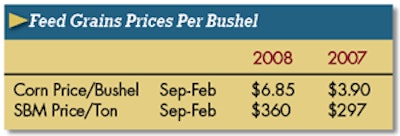
It has been a tough year for the broiler industry, with several companies suffering economic losses in spite of record wholesale prices. In July, many decided demand was not what they expected, so egg sets took a downward turn to reduce supply. U.S. broiler supply should decline from the fourth quarter on until profits return. That could be middle or late next year when costs have reduced enough.
Consumers will continue to be conservative as their budgets are also squeezed in this economic adjustment period. It is not unusual for capitalist systems to have peaks and valleys over several years. So this slow economic period will pass and those that survive will prosper.
High costs were not the only factors that caused low returns; combined meat supply was huge. Red meat production during the first six months was up 6.2 percent, with pork up 10.3 percent and beef up 3 percent. If that was not enough, young-chicken production was up 5.3 percent and turkey increased 7.2 percent from a year ago. Most of this meat was consumed here or abroad as exports were strong and are expected to stay healthy.
Don't expect feed grains to be lower in crop year 2008-2009. Farmers are faced with increased non-land costs that could be 35 percent higher than in 2007-2008 and 81 percent higher than two years ago. Some of these costs will not lower rapidly, like fertilizer and seed. So, plan to put higher feed costs into the five-year production schedule.
World coarse grain 2008-2009 ending stocks-to-use could be 12 percent versus 14 percent in 2007-2008, which was larger than in 2006-2007. U.S. ending stocks-to-use are also projected smaller due to a 30 million ton decline in supplies. Ending stocks could be 7 percent of use versus 12 to 13 percent these past two years. Thus considerably higher prices are expected.
Oilseeds supplies in the world are expected to be sufficient to meet demand with ending stocks-to-use near 14 percent. But in the U.S., with its early growing period problems, ending stocks-to-use could be near 2007-2008, of 5 percent versus 18 percent two years ago. Imports from South America will help keep prices from skyrocketing.
Survival of the fittest is the challenge again.
















